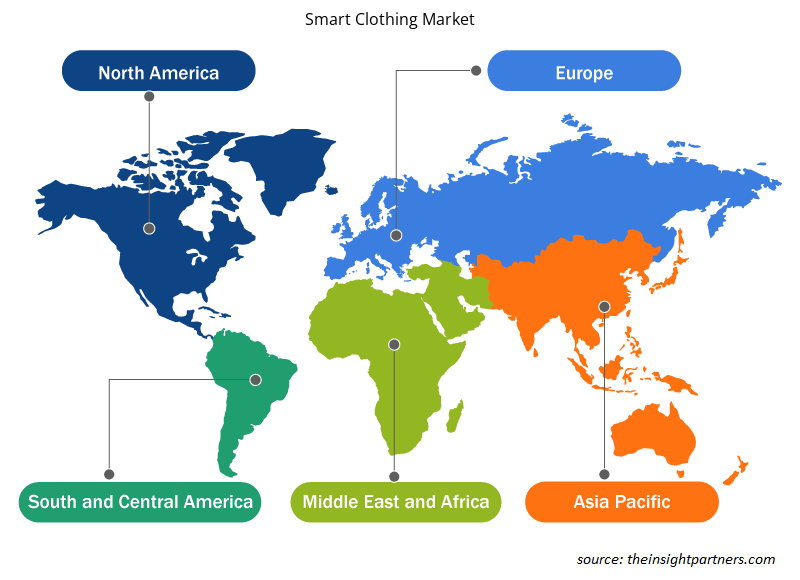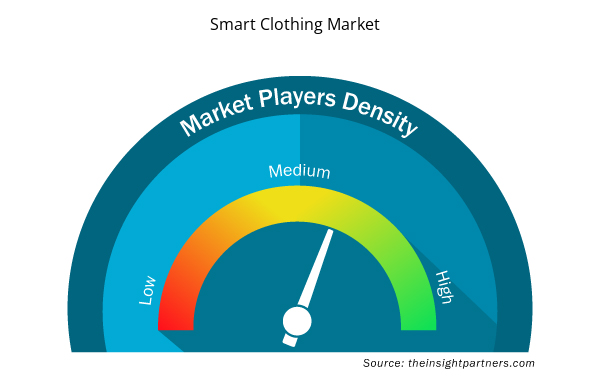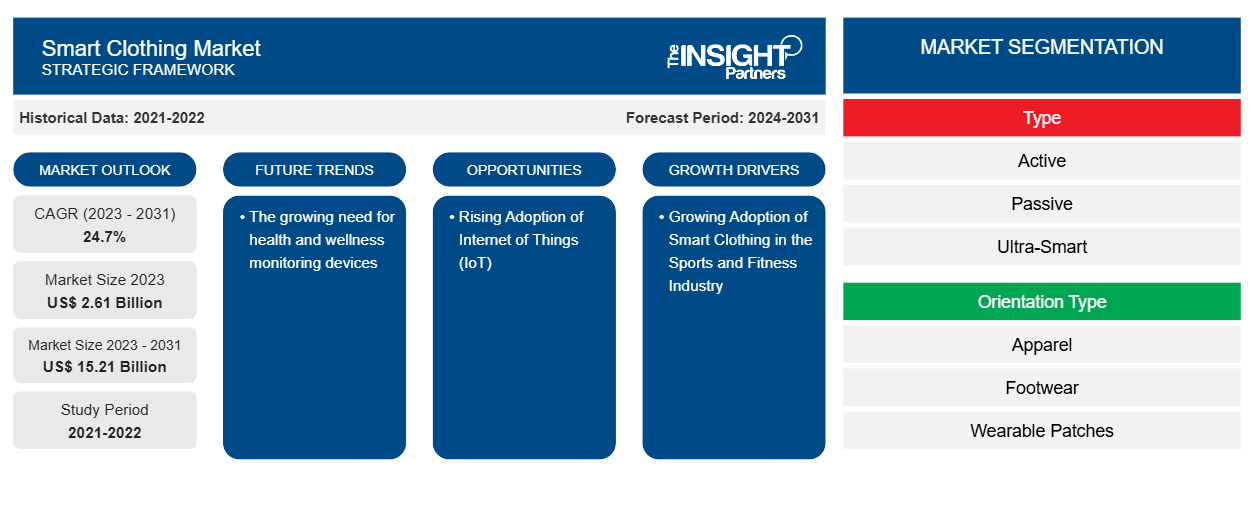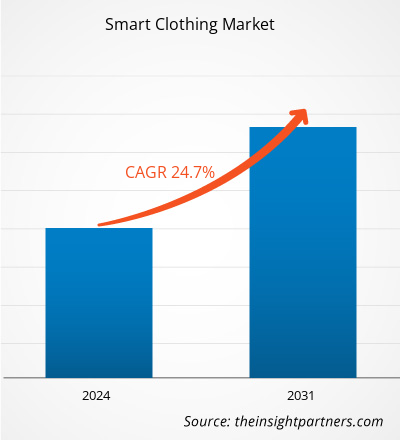من المتوقع أن يصل حجم سوق الملابس الذكية إلى 15.21 مليار دولار أمريكي بحلول عام 2031 من 2.61 مليار دولار أمريكي في عام 2023. ومن المتوقع أن يسجل السوق معدل نمو سنوي مركب بنسبة 24.7٪ في الفترة 2023-2031. ومن المرجح أن تظل الحاجة المتزايدة إلى أجهزة مراقبة الصحة والعافية أحد الاتجاهات الرئيسية في سوق الملابس الذكية.
تحليل سوق الملابس الذكية
يشهد سوق الملابس الذكية نموًا سريعًا بسبب التبني المتزايد للملابس الذكية في صناعة الرياضة واللياقة البدنية والتبني المتزايد لأجهزة الاستشعار لمراقبة الأنشطة الجسدية. ويتوسع السوق بشكل مطرد، مدفوعًا بالتبني المتزايد للأجهزة القابلة للارتداء. وعلاوة على ذلك، يوفر التبني المتزايد لإنترنت الأشياء (IoT) فرصًا مربحة لنمو السوق.
نظرة عامة على سوق الملابس الذكية
تدمج الملابس الذكية الإلكترونيات في الملابس لتحسين المنفعة والاتصال. قد تجمع هذه الملابس البيانات البيومترية، وتقيس مستويات النشاط، وتنظم درجة الحرارة، وحتى توفر ردود فعل لمسية. يوفر سوق الملابس الذكية ملابس ثورية مدمجة بأجهزة استشعار وتقنيات تعمل على إحداث ثورة في الملابس اليومية. تعمل هذه الملابس على تحسين إدارة الصحة ونمط الحياة، بما في ذلك تتبع اللياقة البدنية ومراقبة البيانات البيومترية. إنها توفر بيانات في الوقت الفعلي، مما يسمح للمستخدمين باتخاذ قرارات مستنيرة بشأن صحتهم. إن استخدام المنسوجات الذكية بطريقة لا يعزز الراحة فحسب، بل يشجع أيضًا على اتباع نهج استباقي للصحة، مما يزيد الطلب بين المستهلكين. وبالتالي، فإن هذا يقود السوق.
قم بتخصيص هذا التقرير ليناسب متطلباتك
ستحصل على تخصيص لأي تقرير - مجانًا - بما في ذلك أجزاء من هذا التقرير، أو تحليل على مستوى الدولة، وحزمة بيانات Excel، بالإضافة إلى الاستفادة من العروض والخصومات الرائعة للشركات الناشئة والجامعات
- احصل على أهم اتجاهات السوق الرئيسية لهذا التقرير.ستتضمن هذه العينة المجانية تحليلاً للبيانات، بدءًا من اتجاهات السوق وحتى التقديرات والتوقعات.
محركات وفرص سوق الملابس الذكية
إن الاعتماد المتزايد على الملابس الذكية في صناعة الرياضة واللياقة البدنية هو المحرك للسوق
تتمتع الملابس الذكية بإمكانات هائلة في صناعة الرياضة واللياقة البدنية. يتبنى الرياضيون وعشاق اللياقة البدنية الملابس الذكية بشكل كبير نظرًا لفوائدها، مثل المراقبة في الوقت الفعلي للبيانات الفسيولوجية مثل تشبع الأكسجين ونشاط العضلات ومعدل ضربات القلب وأنماط الحركة. تعد هذه البيانات مفيدة لتحسين برامج التدريب وتقليل مخاطر الإصابة وتحسين الأداء العام. علاوة على ذلك، توفر المعدات الذكية ملاحظات حول الوضع والتقنية والشكل، مما يسمح للرياضيين بإجراء تعديلات وتحسين روتين التمرين الخاص بهم. يساعد دمج الملابس الذكية مع الأجهزة القابلة للارتداء والتطبيقات المحمولة المستخدمين على إنشاء نظام بيئي شامل للياقة البدنية يوفر معلومات وتوصيات فردية للمستخدمين الذين يتطلعون إلى تحسين أهدافهم الصحية.
تزايد استخدام إنترنت الأشياء (IoT) – فرصة في سوق الملابس الذكية
يتيح نمو إنترنت الأشياء التكامل السلس للملابس الذكية مع الهواتف الذكية والساعات الذكية. يعمل هذا الاتصال على تحسين تجارب المستخدم وتمكين وظائف جديدة، ومن المتوقع أن يخلق فرصًا في السوق. يجعل انتشار إنترنت الأشياء الملابس الذكية جزءًا مهمًا بشكل متزايد من النظام البيئي المترابط، مما يوفر للمستخدمين راحة وتنوعًا لا مثيل لهما في حياتهم اليومية. علاوة على ذلك، يشجع الطلب المتزايد على الملابس الذكية الشركات المصنعة على تطوير حلول متقدمة تقنيًا لتلبية متطلبات المستهلكين. على سبيل المثال، في أبريل 2023، ابتكر باحثون في جامعة واترلو "نسيجًا ذكيًا" رائدًا مصنوعًا من ألياف مركبة نانوية بوليمرية مدمجة بأسلاك من الفولاذ المقاوم للصدأ. يتميز هذا النسيج باستجابة خاصة للحرارة والكهرباء، حيث تنقبض الأسلاك المدمجة وتغير شكلها عند تسخينها.
تقرير تحليل تجزئة سوق الملابس الذكية
إن القطاعات الرئيسية التي ساهمت في استخلاص تحليل سوق الملابس الذكية هي النوع ونوع التوجه والاتصال والمستخدم النهائي.
- وفقًا للنوع، ينقسم سوق الملابس الذكية إلى نشطة وسلبية وفائقة الذكاء. احتلت الشريحة النشطة حصة سوقية أكبر في عام 2023.
- من حيث نوع التوجه، تم تقسيم السوق إلى الملابس والأحذية والبقع القابلة للارتداء وغيرها. احتل قطاع الملابس حصة سوقية أكبر في عام 2023.
- على أساس الاتصال، ينقسم سوق الملابس الذكية إلى Wi-Fi وBluetooth وGPS وRFID. احتل قطاع GPS حصة سوقية أكبر في عام 2023.
- من حيث المستخدم النهائي، يتم تصنيف السوق على أنها الرعاية الصحية والأزياء وأسلوب الحياة والرياضة واللياقة البدنية والعسكرية وغيرها. احتل قطاع الرياضة واللياقة البدنية حصة سوقية أكبر في عام 2023.
تحليل حصة سوق الملابس الذكية حسب المنطقة الجغرافية
ينقسم النطاق الجغرافي لتقرير سوق الملابس الذكية بشكل أساسي إلى خمس مناطق: أمريكا الشمالية، ومنطقة آسيا والمحيط الهادئ، وأوروبا، والشرق الأوسط وأفريقيا، وأمريكا الجنوبية/أمريكا الجنوبية والوسطى.
من حيث الإيرادات، استحوذت أمريكا الشمالية على أكبر حصة في سوق الملابس الذكية، وذلك بفضل المبادرة الحكومية المواتية لتعزيز تكنولوجيا الملابس الذكية. على سبيل المثال، في سبتمبر 2023، استثمرت حكومة الولايات المتحدة 22 مليون دولار أمريكي للترويج لمبادرة السراويل الإلكترونية الذكية لتطوير تكنولوجيا ملابس المراقبة الذكية. تخطط الحكومة لإنشاء ملابس يمكن ارتداؤها لتتبع الموقع الجغرافي وتسجيل الصوت / الفيديو ومراقبة البيانات الفسيولوجية للأفراد العسكريين ووكالات الاستخبارات. وهذا يزيد من الوعي الظرفي وجمع البيانات في البيئات الخطرة.
رؤى إقليمية حول سوق الملابس الذكية
لقد قام المحللون في Insight Partners بشرح الاتجاهات والعوامل الإقليمية المؤثرة على سوق الملابس الذكية طوال فترة التوقعات بشكل شامل. يناقش هذا القسم أيضًا قطاعات سوق الملابس الذكية والجغرافيا في جميع أنحاء أمريكا الشمالية وأوروبا ومنطقة آسيا والمحيط الهادئ والشرق الأوسط وأفريقيا وأمريكا الجنوبية والوسطى.

- احصل على البيانات الإقليمية المحددة لسوق الملابس الذكية
نطاق تقرير سوق الملابس الذكية
| سمة التقرير | تفاصيل |
|---|---|
| حجم السوق في عام 2023 | 2.61 مليار دولار أمريكي |
| حجم السوق بحلول عام 2031 | 15.21 مليار دولار أمريكي |
| معدل النمو السنوي المركب العالمي (2023 - 2031) | 24.7% |
| البيانات التاريخية | 2021-2022 |
| فترة التنبؤ | 2024-2031 |
| القطاعات المغطاة | حسب النوع
|
| المناطق والدول المغطاة | أمريكا الشمالية
|
| قادة السوق وملفات تعريف الشركات الرئيسية |
|
كثافة اللاعبين في سوق الملابس الذكية: فهم تأثيرها على ديناميكيات الأعمال
يشهد سوق الملابس الذكية نموًا سريعًا، مدفوعًا بالطلب المتزايد من المستخدم النهائي بسبب عوامل مثل تفضيلات المستهلك المتطورة والتقدم التكنولوجي والوعي المتزايد بفوائد المنتج. ومع ارتفاع الطلب، تعمل الشركات على توسيع عروضها والابتكار لتلبية احتياجات المستهلكين والاستفادة من الاتجاهات الناشئة، مما يؤدي إلى زيادة نمو السوق.
تشير كثافة اللاعبين في السوق إلى توزيع الشركات أو المؤسسات العاملة في سوق أو صناعة معينة. وهي تشير إلى عدد المنافسين (اللاعبين في السوق) الموجودين في مساحة سوق معينة نسبة إلى حجمها أو قيمتها السوقية الإجمالية.
الشركات الرئيسية العاملة في سوق الملابس الذكية هي:
- شركة أي كيو للملابس الذكية
- شركة كارف تكنولوجيز المحدودة (هيكسوسكين)
- دائرة لطيفة
- أبليكون، شركة ذات مسؤولية محدودة
- شركة جابيل
- شركة ميونتيك المحدودة
إخلاء المسؤولية : الشركات المذكورة أعلاه ليست مرتبة بأي ترتيب معين.

- احصل على نظرة عامة على أهم اللاعبين الرئيسيين في سوق الملابس الذكية
أخبار سوق الملابس الذكية والتطورات الأخيرة
يتم تقييم سوق الملابس الذكية من خلال جمع البيانات النوعية والكمية بعد البحث الأولي والثانوي، والتي تتضمن منشورات الشركات المهمة وبيانات الجمعيات وقواعد البيانات. فيما يلي قائمة بالتطورات في سوق الملابس الذكية والاستراتيجيات:
- في أبريل 2023، تعاونت H&M Hennes & Mauritz GBC AB مع LanzaTech لتقديم مجموعة كبسولات مصنوعة من البوليستر CarbonSmart، وهي مادة رائدة تستخدم انبعاثات الكربون المعاد استخدامها. تمكن هذه الشراكة H&M Move من استكشاف المواد المبتكرة والقيام بدورها في المساعدة في إنشاء ملابس رياضية ذكية وأكثر استدامة في المستقبل. (المصدر: H&M Hennes & Mauritz GBC AB، بيان صحفي، 2023)
تقرير سوق الملابس الذكية والتغطية والنتائج المتوقعة
يوفر تقرير "حجم سوق الملابس الذكية والتوقعات (2021-2031)" تحليلاً مفصلاً للسوق يغطي المجالات التالية:
- حجم السوق والتوقعات على المستويات العالمية والإقليمية والوطنية لجميع قطاعات السوق الرئيسية التي يغطيها النطاق
- ديناميكيات السوق مثل المحركات والقيود والفرص الرئيسية
- الاتجاهات المستقبلية الرئيسية
- تحليل مفصل لقوى PEST/Porter الخمس وSWOT
- تحليل السوق العالمي والإقليمي الذي يغطي اتجاهات السوق الرئيسية واللاعبين الرئيسيين واللوائح والتطورات الأخيرة في السوق
- تحليل المشهد الصناعي والمنافسة الذي يغطي تركيز السوق، وتحليل خريطة الحرارة، واللاعبين البارزين، والتطورات الأخيرة
- ملفات تعريف الشركة التفصيلية
- التحليل التاريخي (سنتان)، السنة الأساسية، التوقعات (7 سنوات) مع معدل النمو السنوي المركب
- تحليل PEST و SWOT
- حجم السوق والقيمة / الحجم - عالميًا وإقليميًا وقطريًا
- الصناعة والمنافسة
- مجموعة بيانات Excel



Report Coverage
Revenue forecast, Company Analysis, Industry landscape, Growth factors, and Trends

Segment Covered
This text is related
to segments covered.

Regional Scope
North America, Europe, Asia Pacific, Middle East & Africa, South & Central America

Country Scope
This text is related
to country scope.
الأسئلة الشائعة
The incremental growth expected to be recorded for the global smart clothing market during the forecast period is US$ 12.60 billion.
The global smart clothing market is expected to reach US$ 15.21 billion by 2031.
The key players holding majority shares in the global smart clothing market are AiQ Smart Clothing Inc., Carve Technologies Inc. (Hexoskin), CUTECIRCUIT, Applycon, s. r. o., and Jabil Inc.
The growing need for health and wellness monitoring devices to play a significant role in the global smart clothing market in the coming years.
The growing adoption of smart clothing in the sports and fitness industry and the increasing adoption of sensors for monitoring bodily activities are the major factors that propel the global smart clothing market.
The global smart clothing market was estimated to be US$ 2.61 billion in 2023 and is expected to grow at a CAGR of 24.7% during the forecast period 2023 - 2031.
Trends and growth analysis reports related to Electronics and Semiconductor : READ MORE..
The Insight Partners performs research in 4 major stages: Data Collection & Secondary Research, Primary Research, Data Analysis and Data Triangulation & Final Review.
- Data Collection and Secondary Research:
As a market research and consulting firm operating from a decade, we have published and advised several client across the globe. First step for any study will start with an assessment of currently available data and insights from existing reports. Further, historical and current market information is collected from Investor Presentations, Annual Reports, SEC Filings, etc., and other information related to company’s performance and market positioning are gathered from Paid Databases (Factiva, Hoovers, and Reuters) and various other publications available in public domain.
Several associations trade associates, technical forums, institutes, societies and organization are accessed to gain technical as well as market related insights through their publications such as research papers, blogs and press releases related to the studies are referred to get cues about the market. Further, white papers, journals, magazines, and other news articles published in last 3 years are scrutinized and analyzed to understand the current market trends.
- Primary Research:
The primarily interview analysis comprise of data obtained from industry participants interview and answers to survey questions gathered by in-house primary team.
For primary research, interviews are conducted with industry experts/CEOs/Marketing Managers/VPs/Subject Matter Experts from both demand and supply side to get a 360-degree view of the market. The primary team conducts several interviews based on the complexity of the markets to understand the various market trends and dynamics which makes research more credible and precise.
A typical research interview fulfils the following functions:
- Provides first-hand information on the market size, market trends, growth trends, competitive landscape, and outlook
- Validates and strengthens in-house secondary research findings
- Develops the analysis team’s expertise and market understanding
Primary research involves email interactions and telephone interviews for each market, category, segment, and sub-segment across geographies. The participants who typically take part in such a process include, but are not limited to:
- Industry participants: VPs, business development managers, market intelligence managers and national sales managers
- Outside experts: Valuation experts, research analysts and key opinion leaders specializing in the electronics and semiconductor industry.
Below is the breakup of our primary respondents by company, designation, and region:

Once we receive the confirmation from primary research sources or primary respondents, we finalize the base year market estimation and forecast the data as per the macroeconomic and microeconomic factors assessed during data collection.
- Data Analysis:
Once data is validated through both secondary as well as primary respondents, we finalize the market estimations by hypothesis formulation and factor analysis at regional and country level.
- Macro-Economic Factor Analysis:
We analyse macroeconomic indicators such the gross domestic product (GDP), increase in the demand for goods and services across industries, technological advancement, regional economic growth, governmental policies, the influence of COVID-19, PEST analysis, and other aspects. This analysis aids in setting benchmarks for various nations/regions and approximating market splits. Additionally, the general trend of the aforementioned components aid in determining the market's development possibilities.
- Country Level Data:
Various factors that are especially aligned to the country are taken into account to determine the market size for a certain area and country, including the presence of vendors, such as headquarters and offices, the country's GDP, demand patterns, and industry growth. To comprehend the market dynamics for the nation, a number of growth variables, inhibitors, application areas, and current market trends are researched. The aforementioned elements aid in determining the country's overall market's growth potential.
- Company Profile:
The “Table of Contents” is formulated by listing and analyzing more than 25 - 30 companies operating in the market ecosystem across geographies. However, we profile only 10 companies as a standard practice in our syndicate reports. These 10 companies comprise leading, emerging, and regional players. Nonetheless, our analysis is not restricted to the 10 listed companies, we also analyze other companies present in the market to develop a holistic view and understand the prevailing trends. The “Company Profiles” section in the report covers key facts, business description, products & services, financial information, SWOT analysis, and key developments. The financial information presented is extracted from the annual reports and official documents of the publicly listed companies. Upon collecting the information for the sections of respective companies, we verify them via various primary sources and then compile the data in respective company profiles. The company level information helps us in deriving the base number as well as in forecasting the market size.
- Developing Base Number:
Aggregation of sales statistics (2020-2022) and macro-economic factor, and other secondary and primary research insights are utilized to arrive at base number and related market shares for 2022. The data gaps are identified in this step and relevant market data is analyzed, collected from paid primary interviews or databases. On finalizing the base year market size, forecasts are developed on the basis of macro-economic, industry and market growth factors and company level analysis.
- Data Triangulation and Final Review:
The market findings and base year market size calculations are validated from supply as well as demand side. Demand side validations are based on macro-economic factor analysis and benchmarks for respective regions and countries. In case of supply side validations, revenues of major companies are estimated (in case not available) based on industry benchmark, approximate number of employees, product portfolio, and primary interviews revenues are gathered. Further revenue from target product/service segment is assessed to avoid overshooting of market statistics. In case of heavy deviations between supply and demand side values, all thes steps are repeated to achieve synchronization.
We follow an iterative model, wherein we share our research findings with Subject Matter Experts (SME’s) and Key Opinion Leaders (KOLs) until consensus view of the market is not formulated – this model negates any drastic deviation in the opinions of experts. Only validated and universally acceptable research findings are quoted in our reports.
We have important check points that we use to validate our research findings – which we call – data triangulation, where we validate the information, we generate from secondary sources with primary interviews and then we re-validate with our internal data bases and Subject matter experts. This comprehensive model enables us to deliver high quality, reliable data in shortest possible time.


 احصل على عينة مجانية لهذا التقرير
احصل على عينة مجانية لهذا التقرير